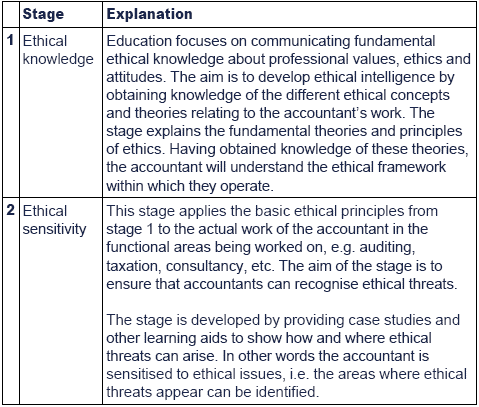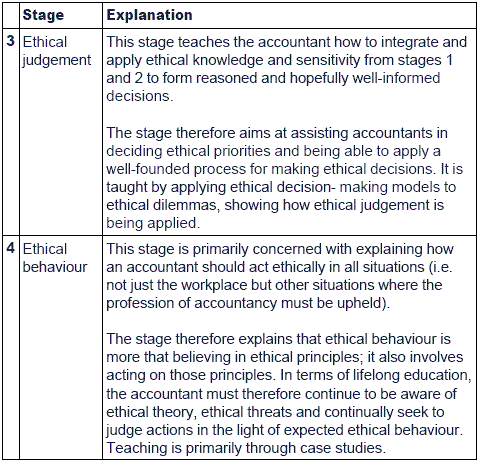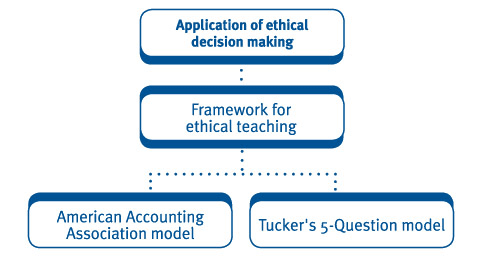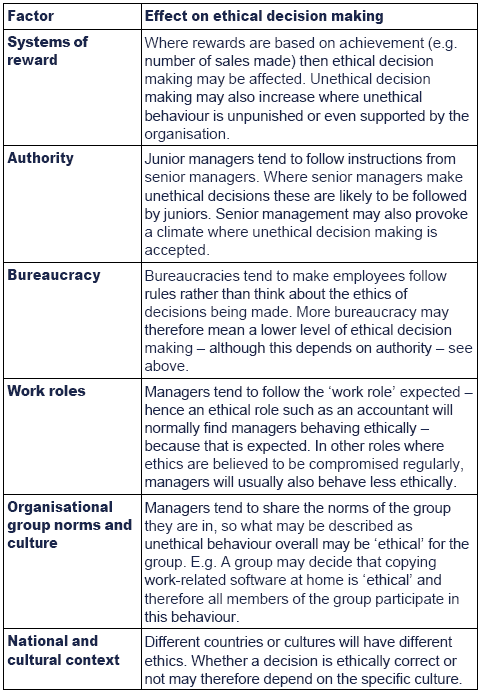Ethical decision making
This page looks at ethical decision making as applied to individuals within the workplace. A more introductory discussion on the nature of ethics can be found here and a more theoretical page on different theories of ethics can be found here.
All employees will need to make decisions whilst at work. These decisions should be ethical.
The IAESB ethics framework
The IAESB Ethics Education Framework (EEF) shown below is designed to provide a structure for the development of ethical education. It recognises that ethics education is actually a lifelong process and will continue through the career of an accountant or any other professional. The framework establishes a four-stage learning continuum which professionals will generally move through during their careers


The above framework for ethical teaching can be applied to ethical decision making via two models:

- The American Accounting Association model provides a series of questions regarding the application of ethics.
- The Tucker model provides a brief framework for considering whether or not a decision is ethical.
The American Accounting Association (AAA) model
The American Accounting Association model provides a framework within which an ethical decision can be made.
The seven question in the model are:
(1) Establishing the facts of the case.
This step means that when the decision-making process starts, there is no ambiguity about what is under consideration.
(2) Identify the ethical issues in the case.
This involves examining the facts of the case and asking what ethical issues are at stake.
(3) An identification of the norms, principles, and values related to the case.
This involves placing the decision in its social, ethical, and, in some cases, professional behaviour context. In this last context, professional codes of ethics or the social expectations of the profession are taken to be the norms, principles, and values.
For example, if stock market rules are involved in the decision, then these will be a relevant factor to consider in this step.
(4) Each alternative course of action is identified.
This involves stating each one, without consideration of the norms, principles, and values identified in Step 3, in order to ensure that each outcome is considered, however appropriate or inappropriate that outcome might be.
(5) Matching norms, principles, and values to options
The norms, principles, and values identified in Step 3 are overlaid on to the options identified in Step 4. When this is done, it should be possible to see which options accord with the norms and which do not.
(6) The consequences of the outcomes are considered.
Again, the purpose of the model is to make the implications of each outcome unambiguous so that the final decision is made in full knowledge and recognition of each one.
(7) The decision is taken.
Tucker's 5-question model
Tucker provides a 5-question model against which ethical decisions can be tested. It is therefore used after the AAA model shown above to ensure that the decision reached is 'correct'. Is the decision:
Stages of ethical decision making
Ethical decision making involves:
- a 4-stage process
- is influenced by individual and situational factors
- can be applied to Kohlberg's CMD theory in terms of business decision making.
The four stages of ethical decision making can be summarised as follows:
The model distinguishes between
- knowing what is the correct thing to do (recognising the moral issue) and
- the actual action taken (the moral behaviour - or lack of it).
So the salesperson could still lie about the cars being sold even though this had been recognised as immoral behaviour.
Factors influencing the moral decision:
The actual moral decision taken will depend on:
- Individual factors: unique characteristics of the individual making the decision such as age, gender, and experience acquired during life.
- Situational factors: particular factors in the decision area that cause an individual to make an ethical or unethical decision.
- Individual factors become more important in higher-level decisions. The decision maker is making ethical decisions because they themselves believe that is the correct course of action.
- Situational factors appear to be more important at lower-level decisions. In these areas, the decision maker appears to make decisions based on what is expected of them in that situation, rather than on their own values and beliefs.
Accountants are normally expected to behave ethically. However, that behaviour also depends on:
- the nature of the ethical issue - issue-related factors, and
- the context in which the issue takes place - context-related factors.
Issue-related factors
- How important the decision is to the decision maker.
- The higher the intensity, the more likely it is that the decision maker will make an ethical rather than an unethical decision.
Moral intensity
The factors affecting moral intensity are shown below.
Actions with higher intensity are noted for each factor.
Moral framing
This refers to the language in which moral issues are discussed in the workplace - a problem or dilemma can be made to appear inoffensive if described (or 'framed') in a certain way.
This may lead to people in different organisations perceiving the moral intensity differently.
- Where morals are discussed openly then decision making is likely to be more ethical.
- Use of moral words (e.g. integrity, honesty, lying and stealing) will normally provide a framework where decision making is ethical.
- However, many businesses use 'moral muteness' which means that morals are rarely discussed so ethical decision making may suffer.
Context-related factors
These factors relate to how a particular issue would be viewed within a certain context.
For example:
- If certain behaviours are seen to be rewarded, encouraged, or demanded by superiors despite being ethically dubious, decision making may be affected.
- If everyone in a workplace does something in a certain way, an individual is more likely to conform: this can result in both higher and lower standards of ethical behaviour.
Managers tend to reframe moral decisions into organisational or practical issues for one of three reasons:
(1) harmony - belief that moral talk would promote confrontation and recrimination
(2) efficiency - belief that moral talk could cloud issues making decision making more time consuming
(3) image of power and effectiveness - managers believe that their image will suffer if they are seen to be idealistic, i.e. making decisions for ethical reasons.
However, where the approach to moral dilemmas tends to the 'principles-based' then reframing moral decisions is inappropriate. There are no rules to follow, therefore ethics must be discussed and actions justified based on sound ethical judgement.

|
Created at 8/14/2012 12:44 PM by System Account
(GMT) Greenwich Mean Time : Dublin, Edinburgh, Lisbon, London
|
Last modified at 9/27/2013 3:48 PM by System Account
(GMT) Greenwich Mean Time : Dublin, Edinburgh, Lisbon, London
|
|
|
|
 |
Rating
:
|
 Ratings & Comments
(Click the stars to rate the page) Ratings & Comments
(Click the stars to rate the page)
|
 |
Tags:
|
|
|
|
|